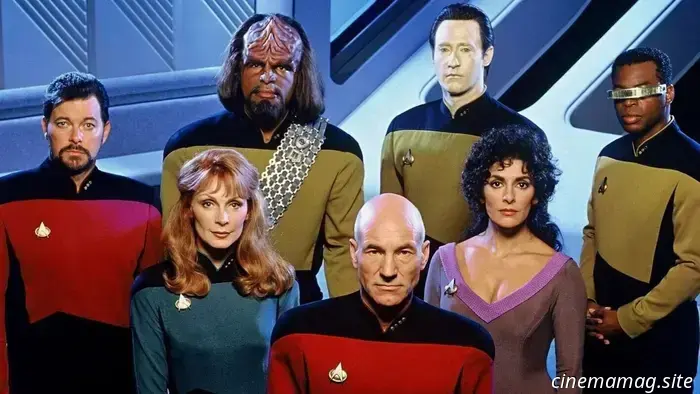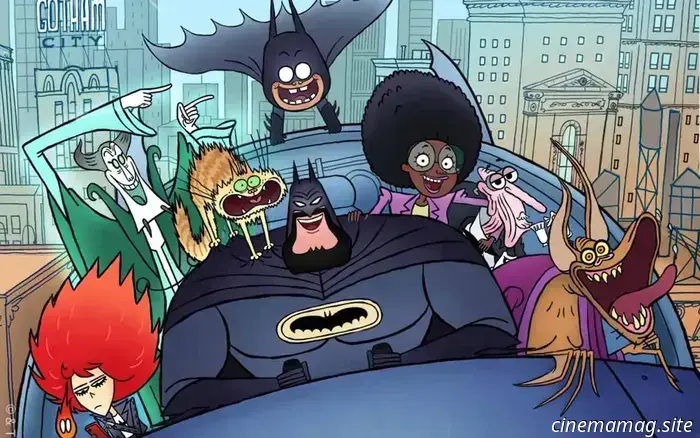
The Top 10 Episodes of Star Trek: The Next Generation
Simon Thompson reflects on the finest episodes of Star Trek: The Next Generation…
Anyone who knows me for a while is aware of my deep admiration for Star Trek: The Next Generation, considering I often discuss the movies, TV shows, games, and books that I enjoy. To me, The Next Generation stands out as one of the greatest pieces of science fiction, as it is both thought-provoking and emotionally resonant, with plenty of action. Its greatness stems from the wide array of stories it tells, particularly in contrast to Kurtzman Trek, which tends towards relentless violence and childish behavior among adults.
Narrowing down my favorite episodes (please note that this selection is personal, so refrain from sending angry messages if your beloved episode isn't included) to just ten will be a challenge, but here’s my best shot. Expect some minor spoilers throughout for a show that concluded in 1994…
10. Darmok (Season 5)
Communication connects all sentient beings and is vital for the survival of every species. "Darmok" is a standout episode, placing Picard and the crew in a scenario where their primary strength is interrupted, forcing them to find a new communication method. The Enterprise encounters a Tamarian ship, a race that uses an intricate language of allegories and metaphors rooted in their ancient myths. Starfleet’s universal translators, capable of deciphering most alien tongues, struggle with their speech. Picard is captured by the Tamarian captain Dathon (guest star Paul Winfield), leading him to a survival situation on a perilous planet where his diplomatic skills become critical.
What makes "Darmok" exceptional is its almost intimate two-character interaction between Patrick Stewart and Paul Winfield. The growing bond between Picard and Dathon is a delight to witness, showcasing two individuals from entirely different cultures joining forces to address a common challenge. The moment when Picard shares The Epic Of Gilgamesh with Dathon never fails to move me, brilliantly illustrating the humanistic essence of TNG at its peak.
9. Yesterday’s Enterprise (Season 3)
TNG effectively tackles ethical dilemmas, one of the best instances being "Yesterday’s Enterprise." A temporal rift transports the destroyed USS Enterprise C from two decades prior into the current timeline. The presence of the Enterprise C creates a paradox within the Enterprise D’s history, where the Federation is embroiled in perpetual conflict with the Klingon Empire. Picard and his crew face the moral quandary of choosing to either let the Enterprise C remain in their time, escaping destruction with significant implications for the timeline, or send them back into the temporal rift, facing certain death.
The episode excels for two main reasons. Firstly, witnessing the crew gradually recognize that something is amiss enhances character development, and secondly, it reinterprets Tasha Yar's death from season one, transforming it from a disappointing moment into one of heroic sacrifice. The delicate balance between speculative science fiction and human drama is vividly displayed in "Yesterday’s Enterprise," culminating in one of the most poignant concluding ten minutes of any TV episode I’ve encountered.
8. Sins of the Father (Season 3)
I considered placing "Cause and Effect" here instead, but ultimately preferred "Sins of the Father" since, despite "Cause and Effect" being a fantastic episode, it frequently appears on lists like this, overshadowing lesser-known gems like this one. Worf is one of my favorite characters in Star Trek; while he certainly shines in Deep Space Nine, he has several memorable character-focused episodes in TNG, with "Sins of the Father" being the most notable.
The episode opens with Klingon officer Kurn ( expertly portrayed by guest star Tony Todd) arriving on the Enterprise as part of a Federation-Klingon exchange program. Kurn’s abrasive demeanor and strict command style quickly clash with the Enterprise crew, testing Picard’s diplomatic skills. Eventually, it is revealed that Kurn is Worf’s brother, summoned to inform Worf that their deceased father is being posthumously charged as a traitor by the High Council, necessitating Worf’s immediate presence on Qo'noS to clear their family name.
Worf's internal struggle between his Klingon heritage and the values instilled in him by the Federation officer who adopted him makes him a fascinating character. These contrasting attributes are what render "Sins of the Father" such a gripping episode, as we see Worf confronted by both sides of his identity. This episode not only offers a deep emotional narrative but also provides intriguing insights into Klingon customs, securing their place as one of the most recognizable and beloved alien races within the Star Trek universe—truly a two-for-one deal.
7. Chain of Command Parts I-II (Season 6)
"Chain of Command" represents the darkest hour of TNG by far. Premiering a week before Deep Space Nine, this episode showcases the true malevolence of the












Other articles
 Discover the Bat-Fam with the trailer for Prime Video’s upcoming DC animated series.
Today at New York Comic Con, Prime Video unveiled the official trailer for the animated action comedy series Bat-Fam, which serves as a sequel to the holiday film Merry Little Batman. The series features Bruce…
Discover the Bat-Fam with the trailer for Prime Video’s upcoming DC animated series.
Today at New York Comic Con, Prime Video unveiled the official trailer for the animated action comedy series Bat-Fam, which serves as a sequel to the holiday film Merry Little Batman. The series features Bruce…
 12 Timeless Rock Songs Influenced by Classic Films
These 12 classic rock songs were influenced by beloved classic films. Clearly, great works acknowledge each other.
12 Timeless Rock Songs Influenced by Classic Films
These 12 classic rock songs were influenced by beloved classic films. Clearly, great works acknowledge each other.
 Comic Book Teaser – Batman/Superman: World’s Finest #44
This Wednesday, Supergirl and Robin set off on a road trip in Batman/Superman: World’s Finest #44. You can take a look at the official preview of the issue below…
Comic Book Teaser – Batman/Superman: World’s Finest #44
This Wednesday, Supergirl and Robin set off on a road trip in Batman/Superman: World’s Finest #44. You can take a look at the official preview of the issue below…
 Starting at under $30,000, the 2026 Leaf is a comfortable and efficient electric vehicle with a range exceeding 300 miles.
by Michael Gauthier
PROS ›› Comfortable ride, 303-mile range, base price of $29,990 CONS ›› Cramped second row, peculiar charging features, only available as FWD
The removal of the clean vehicle tax incentive in the U.S. is anticipated to hinder electric vehicle uptake, yet newcomers continue to emerge. Among them is the reimagined Nissan Leaf, which appears well-suited for this new era without credits.
When it hits dealerships in the upcoming weeks, priced from $29,990, it will be the most affordable electric vehicle available in the U.S. A less expensive model is also rumored to be in development, potentially starting at $25,360.
Additionally, Nissan has hinted at producing a Leaf NISMO if there’s sufficient demand.
In both instances, the 2026 Leaf remains significantly below Tesla’s entry-level models, the larger Model 3 and Model Y Standard, which compromise on many features to meet their price points of $36,990 and $39,990 respectively.
However, compared to those models, the Leaf offers far more than just a budget-friendly EV. It’s comfortable, quiet, and surprisingly fast, benefiting from experiences learned from its last two generations, providing it an advantage over numerous competitors.
QUICK FACTS
*Manufacturer
A Crossover-Inspired Design
When the original Leaf debuted in 2010, it presented as an unconventional hatchback. The second generation, released seven years later, featured a more traditional design, though it arrived at an unfortunate time as crossovers began to dominate sales.
The trend has continued to grow, making the transformation of the third-generation Leaf into a crossover quite predictable. This change was a smart move, as the model appears upscale, incorporating premium features such as flush door handles and a dimming panoramic glass roof.
This roof feature, typically found on high-end vehicles like the Cadillac Celestiq and McLaren 750S Spider, is standard on the $38,990 Leaf Platinum+. While not the most extravagant option on the market, it seamlessly transitions from clear to opaque at the touch of a button, mimicking a classic sunshade.
The dimming roof serves as a cool and practical feature, enhancing aerodynamics and headroom compared to a conventional moonroof, while also providing better insulation against heat and cold, boosting efficiency.
The 2026 Leaf showcases a sleek front with LED headlights connected by a slim illuminated strip, accentuating the crossover’s width, which has increased by 0.8 inches (20 mm).
Conversely, many other dimensions have decreased: the crossover is 3 inches (76 mm) shorter, with a 0.4-inch (10 mm) reduction in wheelbase, and the height has also lowered by 0.4 inches (10 mm), indicating the old hatchback was taller than the new crossover.
Notably, ground clearance has reduced from 5.9 inches (150 mm) to 5.3 inches (135 mm). This is surprising, and the design team deserves credit for creating a model that appears more robust and capable than it actually is.
The Leaf employs soft curves and fluid surfaces, accompanied by concealed rear door handles and a prominent spoiler, which collectively help reduce the drag coefficient from 0.29 to 0.26.
Additional highlights include 18- or 19-inch wheels and an optional motion-activated power liftgate. The model also offers an attractive two-tone paint job, along with 3D holographic taillights featuring a “2-3” emblem, pronounced as “ni-san” in Japanese.
A Comfortable, Yet Constricted Interior
Nissan’s ambition to offer a ‘class above’ experience in the latest Leaf is evident inside, as the cabin exudes a surprisingly upscale feel. This is particularly true for our top-tier Platinum+ model, which includes dual 14.3-inch screens and a bright heads-up display.
The front is outfitted with heated Zero Gravity seats covered in TailorFit upholstery, claimed by Nissan to be softer than normal leather while also being more durable and eco-friendly as it consists of 65% recycled materials.
The front seats are well-padded, featuring a unique pattern that enhances the interior. They also offer power adjustments and lumbar support for optimal comfort.
Regrettably, the rear seating area is less impressive, as the legroom felt cramped for this 6’2” reviewer, with only 31.8 inches (808 mm) available. However, headroom is ample, and the rear seats come equipped with heating, two USB-C charging ports, and air vents.
In terms of cargo capacity, the Leaf provides 20 cubic feet (566 liters) behind the second row, expandable to 55.5 cubic feet (1,572 liters) by folding down
Bradley Cooper’s Is This Thing On? begins with a question that is both straightforward and deeply intricate: is this thing finished? Alex and Tess Novak, played by Will Arnett and Laura Dern, find themselves desperate after years of marriage. Although they adore their mischievous sons, it doesn’t compensate for their dissatisfaction with life.
Starting at under $30,000, the 2026 Leaf is a comfortable and efficient electric vehicle with a range exceeding 300 miles.
by Michael Gauthier
PROS ›› Comfortable ride, 303-mile range, base price of $29,990 CONS ›› Cramped second row, peculiar charging features, only available as FWD
The removal of the clean vehicle tax incentive in the U.S. is anticipated to hinder electric vehicle uptake, yet newcomers continue to emerge. Among them is the reimagined Nissan Leaf, which appears well-suited for this new era without credits.
When it hits dealerships in the upcoming weeks, priced from $29,990, it will be the most affordable electric vehicle available in the U.S. A less expensive model is also rumored to be in development, potentially starting at $25,360.
Additionally, Nissan has hinted at producing a Leaf NISMO if there’s sufficient demand.
In both instances, the 2026 Leaf remains significantly below Tesla’s entry-level models, the larger Model 3 and Model Y Standard, which compromise on many features to meet their price points of $36,990 and $39,990 respectively.
However, compared to those models, the Leaf offers far more than just a budget-friendly EV. It’s comfortable, quiet, and surprisingly fast, benefiting from experiences learned from its last two generations, providing it an advantage over numerous competitors.
QUICK FACTS
*Manufacturer
A Crossover-Inspired Design
When the original Leaf debuted in 2010, it presented as an unconventional hatchback. The second generation, released seven years later, featured a more traditional design, though it arrived at an unfortunate time as crossovers began to dominate sales.
The trend has continued to grow, making the transformation of the third-generation Leaf into a crossover quite predictable. This change was a smart move, as the model appears upscale, incorporating premium features such as flush door handles and a dimming panoramic glass roof.
This roof feature, typically found on high-end vehicles like the Cadillac Celestiq and McLaren 750S Spider, is standard on the $38,990 Leaf Platinum+. While not the most extravagant option on the market, it seamlessly transitions from clear to opaque at the touch of a button, mimicking a classic sunshade.
The dimming roof serves as a cool and practical feature, enhancing aerodynamics and headroom compared to a conventional moonroof, while also providing better insulation against heat and cold, boosting efficiency.
The 2026 Leaf showcases a sleek front with LED headlights connected by a slim illuminated strip, accentuating the crossover’s width, which has increased by 0.8 inches (20 mm).
Conversely, many other dimensions have decreased: the crossover is 3 inches (76 mm) shorter, with a 0.4-inch (10 mm) reduction in wheelbase, and the height has also lowered by 0.4 inches (10 mm), indicating the old hatchback was taller than the new crossover.
Notably, ground clearance has reduced from 5.9 inches (150 mm) to 5.3 inches (135 mm). This is surprising, and the design team deserves credit for creating a model that appears more robust and capable than it actually is.
The Leaf employs soft curves and fluid surfaces, accompanied by concealed rear door handles and a prominent spoiler, which collectively help reduce the drag coefficient from 0.29 to 0.26.
Additional highlights include 18- or 19-inch wheels and an optional motion-activated power liftgate. The model also offers an attractive two-tone paint job, along with 3D holographic taillights featuring a “2-3” emblem, pronounced as “ni-san” in Japanese.
A Comfortable, Yet Constricted Interior
Nissan’s ambition to offer a ‘class above’ experience in the latest Leaf is evident inside, as the cabin exudes a surprisingly upscale feel. This is particularly true for our top-tier Platinum+ model, which includes dual 14.3-inch screens and a bright heads-up display.
The front is outfitted with heated Zero Gravity seats covered in TailorFit upholstery, claimed by Nissan to be softer than normal leather while also being more durable and eco-friendly as it consists of 65% recycled materials.
The front seats are well-padded, featuring a unique pattern that enhances the interior. They also offer power adjustments and lumbar support for optimal comfort.
Regrettably, the rear seating area is less impressive, as the legroom felt cramped for this 6’2” reviewer, with only 31.8 inches (808 mm) available. However, headroom is ample, and the rear seats come equipped with heating, two USB-C charging ports, and air vents.
In terms of cargo capacity, the Leaf provides 20 cubic feet (566 liters) behind the second row, expandable to 55.5 cubic feet (1,572 liters) by folding down
Bradley Cooper’s Is This Thing On? begins with a question that is both straightforward and deeply intricate: is this thing finished? Alex and Tess Novak, played by Will Arnett and Laura Dern, find themselves desperate after years of marriage. Although they adore their mischievous sons, it doesn’t compensate for their dissatisfaction with life.
 The comic series titled Tim Burton's The Nightmare Before Christmas: The Shiver of Christmas Town will be released in January.
Following the successful launch of the bestselling graphic novel Long Live the Pumpkin Queen, Dynamite Entertainment has revealed plans to revisit the universe of Tim Burton’s The Nightmare Before Christmas...
The comic series titled Tim Burton's The Nightmare Before Christmas: The Shiver of Christmas Town will be released in January.
Following the successful launch of the bestselling graphic novel Long Live the Pumpkin Queen, Dynamite Entertainment has revealed plans to revisit the universe of Tim Burton’s The Nightmare Before Christmas...
The Top 10 Episodes of Star Trek: The Next Generation
Simon Thompson reflects on the greatest episodes of Star Trek: The Next Generation… Anyone who has known me for a while is aware that I'm a big admirer of Star Trek: The Next Generation…
